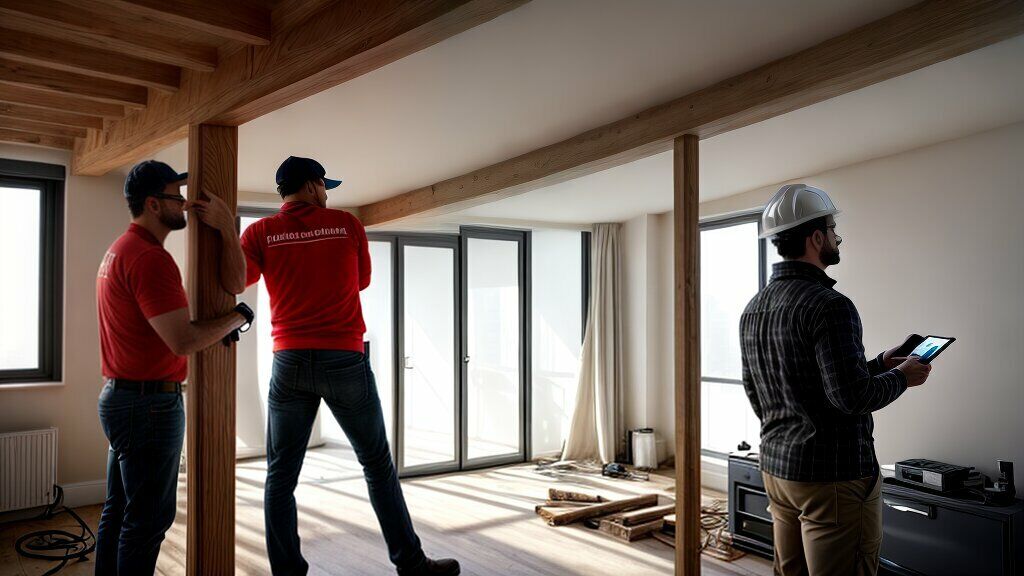How to Tell if a Load-Bearing Wall Has Been Removed | Expert Tips
If you’re considering a home renovation project or have recently moved into a new property, it’s crucial to be aware of the signs of load-bearing wall removal. Load-bearing walls play a crucial role in the structural integrity of your home, and their removal can have serious consequences if not done correctly.
In this section, we’ll provide expert tips on how to identify if a load-bearing wall has been removed in your home. We’ll also explain the importance of load-bearing walls and the potential risks associated with their removal.
Key Takeaways
- Load-bearing walls are essential for the stability of your home’s structure
- Visual signs can indicate if a load-bearing wall has been removed, including changes in layout and cracks in adjacent walls or ceilings
- Professional assessment by a structural engineer is crucial for accurate determination of load-bearing wall removal
- Removing load-bearing walls without proper consideration can result in sagging floors, roof problems, and compromised safety
Identifying Load-Bearing Walls and Understanding Their Importance
Before delving into how to identify a removed load-bearing wall, it’s crucial to understand what load-bearing walls are and why they’re vital for the stability of your home. Load-bearing walls play a pivotal role in supporting the structure of your house. These walls support the weight of the upper levels and roof, transferring the load to the foundation and footings below.
Load-bearing walls are an essential part of the construction of a house, and their removal can have serious consequences for the structural integrity of the building. If a load-bearing wall is removed without installing a proper support system such as columns, beams or headers, it can result in structural damage to the house.
It’s important to note that not all walls are load-bearing. A non-load-bearing wall is typically constructed to divide spaces and does not support the upper parts of the house. It is often possible to remove a non-load-bearing wall without affecting the overall structure of the house.
Visual Signs of Load-Bearing Wall Removal
Removing a load-bearing wall can cause significant damage to your home, compromising its structural integrity. It is crucial to identify the signs of a removed load-bearing wall to prevent any potential risks. Here are some visual indicators to help detect a load-bearing wall removal:
- Changes in layout: One of the most obvious signs of a removed load-bearing wall is a change in the layout of your home. If you suspect that a structural wall has been removed, you can check previous floor plans (if available) and note any changes in door positions etc.
- Cracks in adjacent walls or ceilings: Removing a load-bearing wall can cause cracks to appear in adjacent walls or ceilings. These cracks may be vertical or diagonal and can be a sign that the space where the wall was removed is settling.
- Uneven floors: If you notice a dip or sag in the floor near the area where a load-bearing wall was removed, it could be an indication of weakened structural support. Uneven floors can be a sign that the weight of the home is not being distributed evenly.
It is important to note that these visual signs are not always definitive proof of a removed load-bearing wall. If you suspect that a load-bearing wall has been altered or removed, it is best to seek the opinion of a structural engineer.
Seeking Professional Assessment for Load-Bearing Wall Removal
If you suspect that a load-bearing wall has been removed or altered in your home, it’s crucial to seek the expertise of a structural engineer for a thorough assessment. While visual signs can provide initial clues, a professional inspection will provide a comprehensive analysis and determine whether the wall is, in fact, load-bearing.
During a load-bearing wall inspection, a structural engineer will use various techniques to assess the structure. These could include:
| Technique | Explanation |
|---|---|
| Visual Inspection | The engineer will examine the wall and surrounding areas for any signs of damage or unusual phenomena like cracks. They will survey the structure to determine if there are any issues with the wall’s position, load distribution, or the foundation. |
| Intrusive investigation | The engineer may ask you to remove plasterboard to fully understand what is going on. |
| Load Testing | The engineer may conduct a load test on the structure to evaluate the load-bearing capacity of the walls. A load test can provide valuable information on the load distribution of the structure and the wall’s capacity to support the load safely. |
Once the inspection is complete, the structural engineer will provide a report outlining their findings. The report will detail the load-bearing walls and identify any indications of removal. They will also offer recommendations on how to address any issues that the inspection uncovers.
It’s important to remember that load-bearing walls play a significant role in the structure of a house. As such, any removal or alteration must be done carefully and with the input of a structural engineer to avoid compromising the integrity of the structure. Seeking professional assessment is the best way to ensure that your home remains safe and structurally sound.
Consequences of Removing Load-Bearing Walls
Removing a load-bearing wall without proper consideration can have serious consequences for your home’s structural integrity. It may be tempting to make changes to your home’s layout, but it is crucial to understand the potential risks involved.
One of the most significant risks of load-bearing wall removal is sagging floors. Load-bearing walls are essential for supporting the weight of the structure above them. If a load-bearing wall is removed without proper support, it can cause the floors and ceilings to sag, leading to significant structural issues.
Roof problems are another consequence of load-bearing wall removal. The roof of your home relies on the load-bearing walls for support. If these walls are removed, the roof may begin to sag or collapse, leading to expensive repairs.
Compromised safety is another potential risk of load-bearing wall removal. When load-bearing walls are removed, it can compromise the structural safety of your home, putting you and your family at risk.
It is important to seek the expertise of a structural engineer before making any changes to load-bearing walls in your home. They can assess the situation and provide guidance on how to proceed safely.
Conclusion
Understanding the importance of load-bearing walls and their role in supporting the structure of your home is crucial for homeowners. By being able to identify the signs of removed load-bearing walls, you can ensure the safety and stability of your house. However, it is essential to seek professional assessment from a structural engineer to verify any suspicions and avoid potential risks.
Always prioritise structural safety
Ultimately, home remodeling projects should always prioritize the structural safety of the house. With the help of this guide, homeowners can confidently identify the signs of load-bearing wall removal, seek professional assessment, and make informed decisions that maintain the structural integrity of their homes. Remember, always consult with experts to ensure your house remains structurally sound, and that it will continue to be a safe and happy home for you and your family for many years to come.
FAQ
Q: How can I tell if a load-bearing wall has been removed?
A: Look for visual signs such as changes in the layout, cracks in adjacent walls or ceilings, and uneven floors. However, it is always recommended to seek professional assessment from a structural engineer.
Q: Why are load-bearing walls important?
A: Load-bearing walls play a crucial role in supporting the structure of your home. Their removal can have significant implications for the stability of the construction.
Q: What are the visual signs of load-bearing wall removal?
A: Visual signs include changes in the layout, cracks in adjacent walls or ceilings, and uneven floors. These signs can help you assess the possibility of load-bearing wall removal.
Q: Should I seek professional assessment for load-bearing wall removal?
A: Yes, it is essential to seek the expertise of a structural engineer for a thorough assessment. They can determine the removal and look for indications during their analysis.
Q: What are the consequences of removing load-bearing walls?
A: Removing load-bearing walls without proper consideration can lead to sagging floors, roof problems, and compromised safety. It is important to understand the potential risks before undertaking any home remodeling projects.

